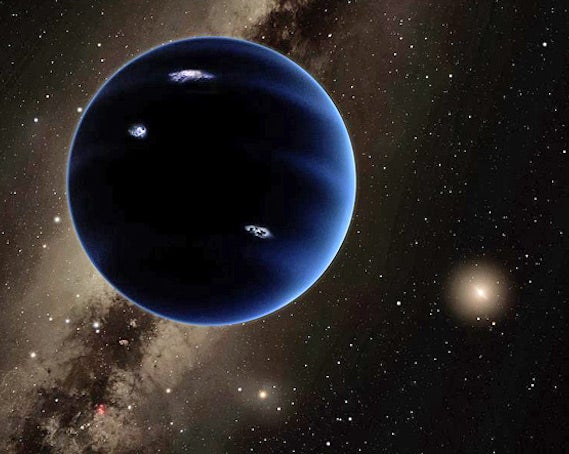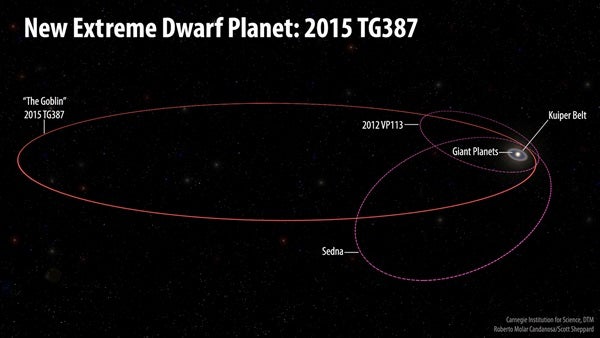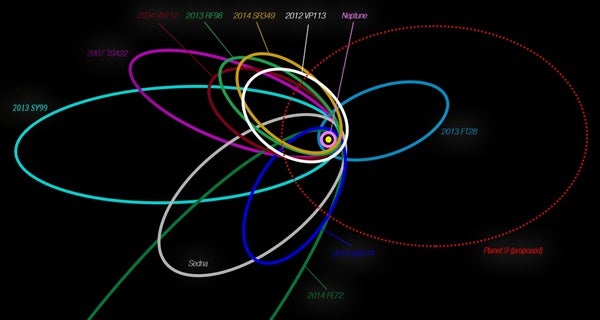The discovery of Farfarout, which is about 140 astronomical units from the Sun (where 1 AU equals the distance between Earth and the Sun), is quite impressive by its own right. But Farfarout and its nearer sibling are not just record-breakers, they could be trend-setters. Depending on how their orbits shake out, the two may add to a growing pile of evidence that hints at the existence of an elusive super-Earth lurking in the fringes of our solar system: Planet Nine.
Finding Farfarout
The discovery of Farfarout was initially announced during a talk on February 21 by astronomer Scott Sheppard of the Carnegie Institution for Science, and first reported by Science magazine. During the presentation, Sheppard told the audience he’d spotted Farfarout just the night before while waiting out a snowstorm.
“It is a fairly faint object discovered by us in January data from the Subaru telescope,” Sheppard told Astronomy via email. “Based on its distance and brightness, it is likely about [250 miles (400 kilometers)] in size.” This is roughly a quarter the diameter of Ceres, which makes Farfarout a relatively small dwarf planet.
Sheppard, along with astronomers David Tholen of the University of Hawaii and Chad Trujillo of Northern Arizona University, have been in the news a lot lately for their slew of distant discoveries. This is because they are currently carrying out the most comprehensive survey of solar system objects beyond Pluto to date. According to Sheppard’s presentation, their survey has netted 80 percent of all the solar system objects discovered past 60 AU so far.
But Sheppard and his team are not done yet. They expect their survey to spot many more of these distant and faint trans-Neptunian Objects (TNOs), which are frozen, rocky bodies located past Neptune in a region called the Kuiper Belt.
“We have covered about 25 percent of the sky to date in our survey,” Sheppard says. And though Farfarout is about at the observational limit of their telescopes, the larger the object, the easier it is to spot, “so there are likely a few bigger objects even farther out than Farfarout that we should be able to detect.”
However, Sheppard stresses the discovery of Farfarout is still preliminary. In order to confirm both the object’s extreme distance and its orbital path, they will need to collect more images of it moving through the sky. “We only have observed Farfarout for a 24-hour time base,” he said last week. “I’m currently in Chile at the Magellan telescope right now and we are hoping for good weather over the next several days in order to re-observe this interesting object.”
Where are you going?
Because Farout and Farfarout are so, well, far out, it’s extremely difficult to pin down their orbits — let alone their compositions. But by using powerful ground-based telescopes, the researchers are working to collect enough data to tease out these details. However, it will take some time.
For instance, in October 2018, the team announced the confirmation of another distant object, which, in the spirit of Halloween, they nicknamed The Goblin. Though the 200-mile-wide (320 km) icy rock was seen about 80 AU away, it has a particularly eccentric orbit, which means it swings out even farther from the Sun. “The Goblin’s orbit is very large, it has a semi-major axis of some 1,000 AU,” Sheppard says, “meaning it takes some 35,000 years to go around the Sun once.”
Officially named 2015 TG387, “The Goblin” is a dwarf planet that was originally seen in the outer solar system in 2015. The Goblin has a very large and eccentric orbit that takes it far from the Sun, but it makes its closest approach (or reaches perihelion) near where many other distant objects do, indicating the orbits of such objects are influenced by a large, unseen world orbiting far beyond the known planets.
Although the team is able to plot the orbits of distant bodies using currently available telescopes, they’ll likely need to wait a few more years before they truly can learn what these objects are made of. But that doesn’t mean they don’t already have a few theories.
“The next generation of telescopes that will come online in the mid 2020s will be more able to get the physical properties of these objects.” Sheppard says. “We did get the colors of The Goblin and Farout and they appear to be pinkish in color, which is the color of some Kuiper Belt objects that are suspected of having a lot of water ice. So we think these objects are a mix of water ice and rock.”
The Hunt for Planet Nine
With the advancement of powerful survey telescopes, as well as sophisticated software that can sift through massive amounts of data like never before, we are just now beginning to scour the distant reaches of the solar system for icy dwarf planets and the like. But small dwarf planets may not be the kings and queens of the Kuiper Belt. There is a growing dossier of evidence that suggests a colossal super-Earth — some five to 15 times the mass of our own planet — is lurking just beyond, playing puppeteer to an oddly clustered collection of eccentric TNOs.
In 2016, Caltech astronomers Kostantin Batygin and Mike Brown published a paper titled, “Evidence for a Distant Giant Planet in the Solar System.” In that paper, they point out that a strange population of scattered TNOs all make their closest approaches to the Sun at about the same location in space, despite having different orbital trajectories. According to study, the odds of such clustering being the result of chance are about 0.007 percent (or 1 in 14,000). Furthermore, Batygin and Brown recently showed there is only about a 0.2 percent chance (or 1 in 500) that such clustering is the result of observational bias.
“Based on the clustering of the objects we are finding that are way out there, like The Goblin,” Sheppard says, “a super-Earth planet that is a few hundred AU away” could be shepherding them all into position. Thanks to cutting-edge simulations, the researchers expect a lurking super-Earth like Planet Nine to be in a somewhat eccentric orbit about 400 AU from the Sun. But Sheppard says “the planet could be up to some 1,500 AU away in the more massive planet models.”
Well, that’s still a very heavily debated question. One possibility is that the solar system got shook up in its past by a wandering star. According to research published late last week, astronomers have discovered an exoplanet — named HD 106906 b — that they think was exiled into a large, perturbed orbit thanks to a pair of rogue stars that strayed too close to the system. Alternatively, Planet Nine may have established its unique and distant orbit after being pushed out during the solar system’s chaotic formation, when the large gas giant planets likely jostled for position.
The problem with Planet Nine is that in order for us to be 100 percent sure it even exists, we need to see it with our own eyes. However, Sheppard says, “our survey is designed to not simply find the planet, but to triple the known very distant objects. These very distant objects are the ones that are sensitive to the planet and nailing down their clustering trends much better will better help us locate the planet and further show it is real.”
By just doubling the number of small objects known to orbit far beyond Neptune (which is currently a sample of about a dozen), the researchers think they can better tease out whether Planet Nine is really there. But for now, Sheppard says, “None of the most distant perihelia objects with large semi-major axes obviously buck the clustering trend, but again, we are talking about only a little more than a handful of objects.”
Although it’s fascinating to ponder whether a hidden planet many times the mass of Earth is skulking in the depths of the outer solar system, there are some alternative theories that can explain the clustering of TNO orbits without the need for Planet Nine. For example, recent research suggests the orbit-perturbing effects of Planet Nine could also be caused by a massive disk of small, icy objects in distant orbits.
However, “the planet hypothesis is the simplest and best explanation and is the reason we proposed it in 2014,” Sheppard says. “A massive disk might be possible, but we don’t see any massive disk out there, and if there were one, it would be harder to explain than just having one planet out there.”
So, although Sheppard and his colleagues are currently carrying out the widest and deepest survey ever for solar system objects beyond Pluto, they still have a ways to go before they can learn the truth about Planet Nine.
But in the meantime, Sheppard says, “It’s exciting to be looking at sky that no one has ever imaged as deeply as we are. It is like Forest Gump said, each image we take is like a box of chocolates, you never know what you are going to find.”












